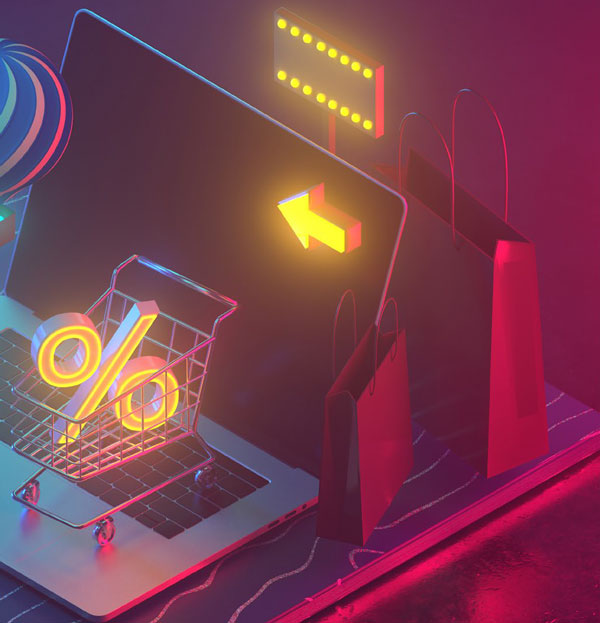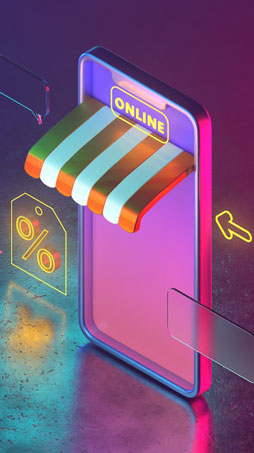The retail landscape has gone through a sea of changes over the last ten years, thanks to technology and consumers who demand a unique shopping experience. Suneeta Kaul lists the disruptive forces and influences that have shaped and re-shaped retail jewellery in the past ten years

The past decade has been so transformative for the business of retail that it bears little resemblance to what it started out to be. Jewellery retail is no exception, and it too has witnessed disruptions that have metamorphosed the way the product is bought and sold. Technology has been the biggest facilitator of this tsunami of change, with forces such as the Internet, social media, online commerce, computer-aided design and manufacturing (CAD-CAM), augmented reality and virtual reality (AR/VR), et al, shaping and re-shaping the simple business of stocking jewellery in a store and selling it to customers completely, and pretty dramatically
Here’s an in-depth look at some of the biggest disruptors retail jewellery has witnessed in the past ten years or so.
1. EMERGENCE OF RETAIL CHAINS
While jewellery continues to be dominated by the unorganized sector, the past decade has seen the emergence of retail chains that have corporatized the retail business. The organised jewellery retail sector has grown significantly on the back of growing consumer awareness, and has penetrated Tier-2 and Tier-3 cities of the country. In fact, small towns are creating new jewellery retail opportunities, with the business becoming more value-driven and experience-driven. Recent government measures, such as mandatory hallmarking and import duty cuts, are expected to give it further momentum.
Explains Ahammed MP, Chairman, Malabar Gold & Diamonds, “Jewellery retail chains have made the trade organised, with transparent business practices and quality assurance. The organised jewellery retail players have also transformed the jewellery buying experience, with exquisite ambiance in the showrooms and welltrained staff offering excellent shopping convenience and comfort. In fact, being a global jewellery retail chain, we offer a world-class shopping experience in all our showrooms and that has helped us immensely in developing stronger customer traction and loyalty. Our ‘One India One Gold Rate’ initiative to offer uniform gold rates across all showrooms in the country has emerged as a key disruptor which has brought in the idea of price standardisation to the trade.” Chain stores, with their glitz and glamour, have played a big role in attracting youngsters to jewellery, and expanding the overall market. Says Hemant Shah, Business Consultant, “One of the biggest disruptors of the past decade is that customers are not solely dependent on the family jeweller. The methodology to purchase jewellery has changed drastically. The emergence of chain stores and the corporatization of jewellery retail has changed the psychology of buyers, as well as sellers.”
“Jewellery retail chains have made the trade organised, with transparent business practices and quality assurance. The organised jewellery retail players have also transformed the jewellery buying experience, with exquisite ambiance in the showrooms and welltrained staff offering excellent shopping convenience and comfort. In fact, being a global jewellery retail chain, we offer a world-class shopping experience in all our showrooms and that Jewellery retail chains have made the trade organised, with transparent business practices and quality assurance. The organised jewellery retail players have also transformed the jewellery buying experience, with exquisite ambiance in the showrooms and well-trained staff offering excellent shopping convenience and comfort. In fact, being a global jewellery retail chain, we offer a world-class shopping experience in all our showrooms and that has helped us immensely in developing stronger customer traction and loyalty. Our ‘One India One Gold Rate’ initiative to offer uniform gold rates across all showrooms in the country has emerged as a key disruptor which has brought in the idea of price standardisation to the trade. Ahammed MP, Chairman, Malabar Gold & Diamonds,

2. UBIQUITOUSNESS OF TECHNOLOGY
Technology has been THE most important and widespread disruptor in all kinds of retail, including jewellery retail. It has pervaded every imaginable nook and cranny of the business, so much so that its use is limited only by the imagination. Right from enabling an online presence to the widespread use of social media, from computer-aided design to AI-based designs on cloud networks, from AR-enhanced shopping experiences to VRpowered online retailing, from the Facebook post to the Instagram hashtag – technology has travelled everywhere in the past decade
Jewellery retailers have finally started making appreciable investments in technology in order to reshape their operations. Interestingly, the past two years have seen jewellers take to technology in a much bigger way than ever before, thanks to the pandemic. Says Rajesh Kalyanaraman, Executive Director, Kalyan Jewellers, “While the digital transformation process was already underway in the jewellery industry, the pandemic has truly accelerated the shift, making it imperative for businesses to adapt to a hybrid business model with the use of technological advancements and digital interventions at multiple points in the purchase cycle. To address the ongoing digital transformation and target the tech-savvy millennial consumers, we are strengthening our omnichannel strategy and focusing on creating a holistic ecosystem, making the ‘phygital’ model more seamless.
“Over the years, we have been making consistent investments in leveraging technology to offer convenient solutions to customers, enabling us to easily venture into newer product categories such as Digital Gold, as well as explore newer avenues, such as Gold Ownership Certificate and LIVE Video Shopping Facility.”
Talking about the sea change in the thinking of jewellery retailers, A Shivaram, Founder, Retail Gurukul, says, “The mindset of the retailer has changed from a feeling of nothing will change, we are an old industry, to a new generation of jewellers taking over and looking to change age old habits, including modernisation of business
While the digital transformation process was already underway in the jewellery industry, the pandemic has truly accelerated the shift, making it imperative for businesses to adapt to a hybrid business model with the use of technological advancements and digital interventions at multiple points in the purchase cycle. To address the ongoing digital transformation and target the tech-savvy millennial consumers, we are strengthening our omnichannel strategy and focusing on creating a holistic ecosystem, making the ‘phygital’ model more seamless. RAJESH KALYANARAMAN Executive Director, Kalyan Jewellers
3. PREVALENCE OF CAD-CAM AND 3D PRINTING
The emergence of CADCAM has been a very important business disruptor in the past decade. This technology changed the very concept of jewellery design and manufacture, leading to far quicker turnaround time of the finished product. Says Aagam Shah, Founder & CEO, Plushvie, “The combination of CAD software and a 3D printer has taken jewellery design to a higher level. The integration of 3D printing technology has speeded up the development of wax models and helped overcome the complex manual processes involved. Less production time, low product cost, quick fixes, complex details are some of the benefits of 3D printing. Through this technology, even customers can participate in the design and creation of their jewellery. It is a quick manufacturing technology and assists in the easy customization of the 3D model, thus reaching the market at a fast pace with lower expenses.”
Agrees Ahammed, “Technology adoption has influenced both manufacturing and retail aspects of the jewellery business. As customization
While the digital transformation process was already underway in the jewellery industry, the pandemic has truly accelerated the shift, making it imperative for businesses to adapt to a hybrid business model with the use of technological advancements and digital interventions at multiple points in the purchase cycle. To address the ongoing digital transformation and target the tech-savvy millennial consumers, we are strengthening our omnichannel strategy and focusing on creating a holistic ecosystem, making the ‘phygital’ model more seamless. RAJESH KALYANARAMAN Executive Director, Kalyan Jewellers

4. POPULARIZATION OF AR/VR
The incorporation of AR/ VR in retail, particularly online retail, has been an exciting development in the jewellery industry. Says Aagam, “In the past decade, technology has introduced possibilities for endless creativity. AR is rapidly growing in popularity because it brings elements of the virtual world into reality, thus enhancing the things we see, hear, and feel. It has made the retail engagement all the more experiential, fascinating and personal, and it's often considered to be in the middle of a mixed reality spectrum -- between the real world and the virtual world.”
The technology is based on enhancing the real-world environment with computergenerated elements. Many plush jewellery brands are already enabling their customers to experience jewellery through AR and 3D modelling before they make a purchase. Virtual catalogues and AR are in vogue among online jewellery platforms now, opening immense business opportunities for jewellery retailers by reducing the inventory expenditure. Adds Aagam, “Customers can try on jewellery virtually, and once a design is finalized, they can virtually shop through diverse channels.This elevates and personalises the customer experience by giving customers a fully-immersive, real-time shopping experience when trying on jewellery, almost as if they were actually in the stores. Studies suggest that viewing jewellery in AR increases conversions by up to 250%, boosts customer engagement by 66%, and reduces returns by 40%. In these pandemic times, this is the best way to create a contactless shopping experience.”
Bijoor has his own take on the use of AR/VR in jewellery retail. “AR and VR and robotics and ML play a role, for sure. This tech will first be used frivolously at the front end of marketing and communication, and then it will make deep inroads into every space at the back-end, starting from sourcing, to quality check, to
manufacturing, to design, and more,” he declares.
5. PREVALENCE OF LAB GROWN DIAMONDS
The emergence of Lab Grown Diamonds has been a major disruptive force in the jewellery industry globally. According to Pooja Sheth, Managing Director, Limelight Lab Grown Diamonds, “What the last decade has seen is clearly a revolutionary breakthrough, with a new product category coming on board through
Lab Grown Diamonds (LGDs). And this, coupled with new innovative designs, looks to be a game changer for years to come. “LGDs, contrary to mined diamonds, are grown through the process of CVD -- Chemical Vapor Deposition.
Analogous to the concept of test-tube babies and naturally born babies, where the process is different but the output is exactly the same, CVD diamonds are 100% real diamonds that are grown by replicating the diamond creation process which occurs below the surface of the earth, bearing the exact same composition, properties and characteristics. The CVD diamond creation process also starts from a natural diamond seed to grow its first CVD diamond. Following that, every seed is replanted from the CVD diamond production itself.
“As there are no mining costs incurred, LGDs enjoy a price advantage. But I don’t see just the price point making LGDs an attractive option. The fact that they are sustainable and environmentally friendly has been a clear purpose behind the purchase of every consumer who has bought from Limelight. Affordability is just the icing on the cake as the pricing benefit is passed on to the consumers. But it is not the main reason behind the purchase. LGDs are making a difference not only in the high fashion market, but they are also here to stay as a differentiated product category in the fine jewellery segment.”
Hemant agrees that LGDs are becoming a disruptive force not just because of their pricing, but other reasons as well. “LGDs are quite popular in the US, and it is only a matter of time before Indian customers hop on to the bandwagon. LGDs are more rare than mined diamonds -- there are all of 5-7 million carats of LGDs in the world. And demand is huge. The price differential makes them an attractive proposition. The budget of customers for diamonds has not come down, they are still earmarking the same amount, if not more. But increasingly, customers prefer to buy LGDs, rather than mined diamonds, and get better quality, more attractive designs, bigger stones, more shine, more shimmer.”
What the last decade has seen is clearly a revolutionary breakthrough, with a new product category coming on board through Lab Grown Diamonds (LGDs). And this, coupled with new innovative designs, looks to be a game changer for years to come.LGDs, contrary to mined diamonds, are grown through the process of CVD -- Chemical Vapor Deposition. Analogous to the concept of test-tube babies and naturally born babies, where the process is different but the output is exactly the same, CVD diamonds are 100% real diamonds that are grown by replicating the diamond creation process which occurs below the surface of the earth, bearing the exact same composition, properties and characteristics. POOJA SHETH Managing Director, Limelight Lab Grown Diamonds

6. MAINSTREAMING OF ONLINE RETAIL
Online selling has been another disruptor that has gained traction over the past few years. While the industry is near unanimous that online commerce in jewellery has a limited scope, and it can, at best, complement the in-store purchases, and that only small-ticket items can sell online, the fact is that it has made inroads in retail jewellery. Says Aagam, “E-shopping is rapidly taking over traditional catalogue-style shopping and providing a much closer to a real high street shopping experience to customers.” Bijoor believes the next new move will be jewellery online. “This is already happening, with the online stores of reputed gold brands, and it will continue to happen in the space of D2C. Direct-to-consumer goldcommerce will be the future over the next ten years. Here, I predict a return to the individual jeweller, with a name for reliability, quality and design efficacy. In many ways, it is the re-appearance of the corner family jeweller one trusts. Retail of jewellery will come full circle.
I believe in India, WhatsApp is the biggest commerce application, underutilized to date. Expect this space to boom, when it comes to jewellery. Wherever you need end-to-end trust, WhatsApp direct commerce is going to be a big market to tap. And let’s remember, jewellery is a deep-trust business. And once you trust your goldsmith, your corner jeweller, your corporate jeweller, your D2C jeweller or your WhatsApp jeweller, you will keep going back to them again and again.”I believe in India, WhatsApp is the biggest commerce application, underutilized to date. Expect this space to boom, when it comes to jewellery. Wherever you need end-to-end trust, WhatsApp direct commerce is going to be a big market to tap. And let’s remember, jewellery is a deep-trust business. And once you trust your goldsmith, your corner jeweller, your corporate jeweller, your D2C jeweller or your WhatsApp jeweller, you will keep going back to them again and again.”
One of the biggest disruptors of the past decade is that customers are not solely dependent on the family jeweller. The methodology to purchase jewellery has changed drastically. The emergence of chain stores and the corporatization of jewellery retail has changed the psychology of buyers, as well as sellers. HEMANT SHAH Business Consultant
7. OMNIPRESENCE OF SOCIAL MEDIA
Social media platforms rule the world – they are inescapable, and their impact on every aspect of life, including retail, has been immense. “The majority of jewellery buyers across the country are digitally connected,” says Ahammed, adding, “Therefore, social media is playing a decisive role in building consumer awareness and influencing preferences and choices. As design discovery is happening on social media, retailers are reaching out to their prospective buyers through digital campaigns, collaborations with social media influencers, etc. Digital campaigns and social media consumer outreach have become part of mainstream retail promotion.”, Agrees Kalyanaraman,“The nationwide lockdown saw a huge increase in the screen time spent by Indians across digital platforms. Social media has emerged as the source of inspiration as well as news for the younger generation. It has contributed to the insatiable demand for something new, unique and ‘Instagrammable’, but when something is quick to trend, it is also very quickly outdated. The industry as a whole has had to transition into a more agile unit, as a result of this growing demand.” Striking a somewhat different note, Shivaram says, “Even though the customer has migrated to social media, it is yet to make a significant impact on the marketing strategy of jewellery retailers. These are still early days, as far as jewellery retailers are concerned, compared to other industries like white goods, or even FMCG.”
8. EMERGENCE OF MILLENNIAL MINDSET
Millennials are a different breed altogether – they think differently, buy differently. And their emergence as empowered customers has forced retailers to rethink their sales strategies. Describing the millennial mindset, Ahammed says, “Millennials are usually attracted to brands that reflect values, ethics, social responsiveness and environmental sustainability. So, brand communication to millennials should represent those aspects. In addition, product promotions need to have a strong storytelling element to engage them. Jewellery aimed at millennials needs to gel with their lifestyle and sensibilities. Take, for example, our social media campaign for our wedding band brand, Ever After. To capture the attention of young men and women, we have weaved a story around the product. Overall, new-age sensibilities of millennials and generation Z have enriched the design discourse of jewellery and reemphasized the out-oflocker value of jewellery.” Besides, millennials do not think of jewellery in terms of gender. Men’s jewellery has become a sizeable market, even in India. Says Aagam, “Luxury watches and heavy gold chains have always been a popular choice, but some additional pieces have become must-haves over the last decade, revolutionising male jewellery. During the last ten years or so, men’s rings, bracelets and iced out pendants have become very fashionable. Moreover, minimalistic jewellery, also known as ‘naked jewellery’ or ‘barely there jewellery’, is now trending. It is affordable and easy to find.”
Adds Sheth, “With younger audiences coming on board, consumer preferences and the very perception of jewellery have begun to see a material shift. Whilst jewellery was always perceived as an investment, the younger audiences don’t necessarily look at jewellery only as an investment.The adornment factor has become one of the most important aspects of purchase, because of which the design aspect of the product has come more and more into the limelight.
Shivaram feels that the industry is yet to understand millennials well enough. “The retail jewellery industry It is still dependent on the wedding market for a significant share of sales, while the millennial expectations have changed, even for wedding jewellery. Millennials are going more for experiences rather than heavyset jewellery.”
Be the first to comment